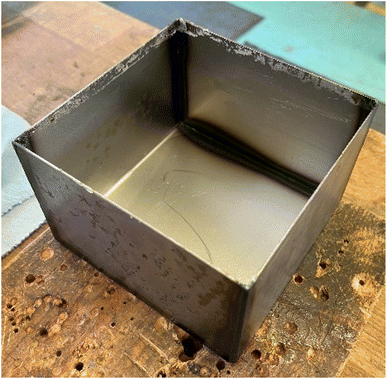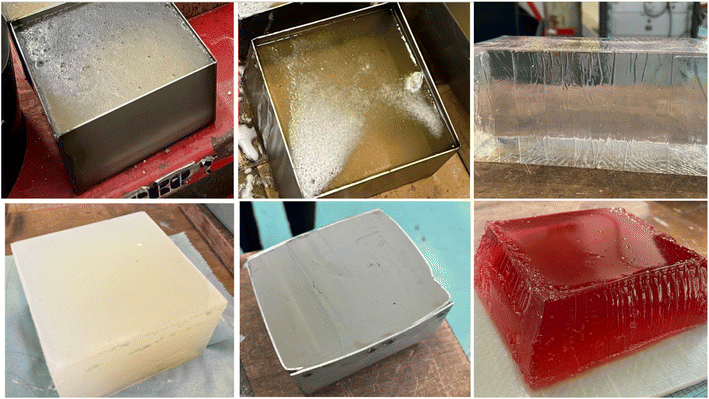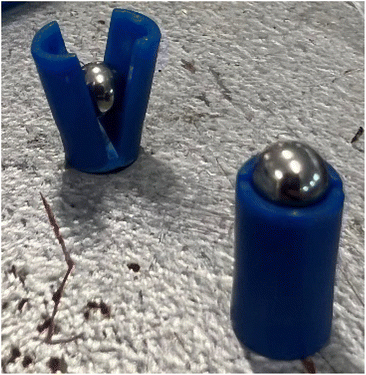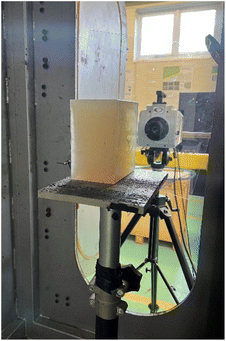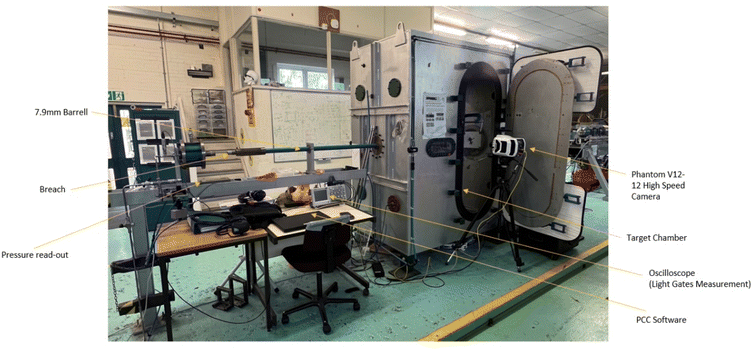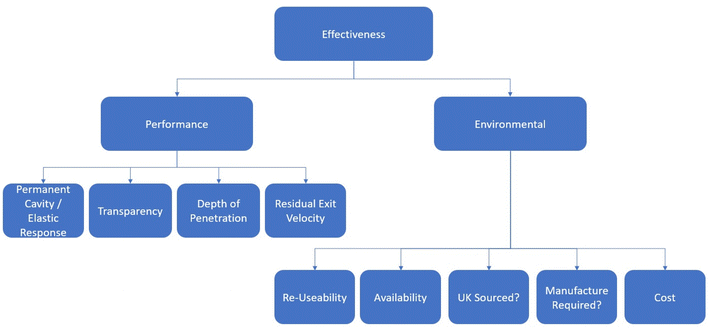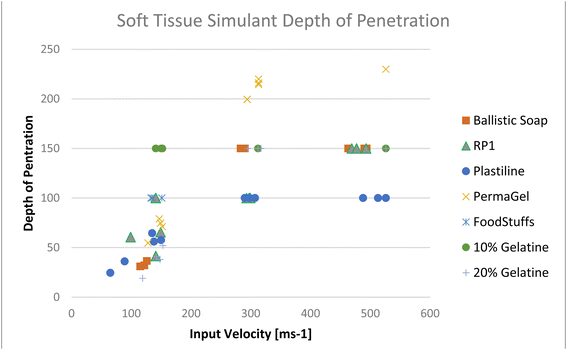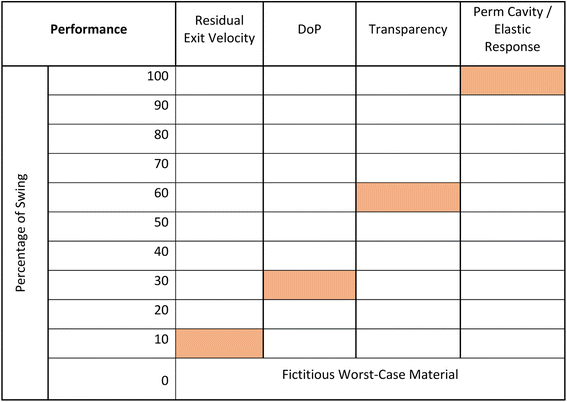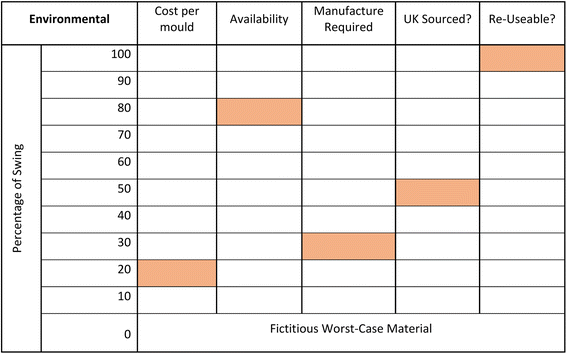 Open Access Article
Open Access ArticleCreative Commons Attribution 3.0 Unported Licence
Evaluation of soft tissue simulant performance against economic and environmental impact
James
Read
 a,
Ken
McNaught
b,
Rachael
Hazael
a and
Richard
Critchley
a,
Ken
McNaught
b,
Rachael
Hazael
a and
Richard
Critchley
 *a
*a
aCranfield Forensic Institute, Cranfield University, Defence Academy of the United Kingdom, Shrivenham, SN6 8LA, UK. E-mail: R.critchley@cranfield.ac.uk
bCentre for Systems, Simulation and Analytics, Cranfield University, Defence Academy of the United Kingdom, Shrivenham, SN6 8LA, UK
First published on 22nd February 2024
Abstract
Soft tissue simulants are traditionally used to provide a post impact medium suitable for replicating human anatomy. Performance of materials is therefore paramount, and the analysis of such experimentation relies on responses that mimic the various tissue, bone and muscle groups contained within the human body. However, with an increasing global push to reduce carbon emissions and increase sustainability, current materials require examination to ensure research establishments remain at the forefront of environmentally friendly practices. To date, the literature contains little in relation to how environmentally friendly the use and supply of soft tissue simulants is. The aim of the research is to provide researchers with primary data to support decisions on material selection for ballistic simulation research. The need arises due to the high cost and environmental impact of existing materials. To explore this research gap, a series of 5.5 mm ball bearings were fired from a gas gun at velocity ranges between 122 and 526 m s−1 to examine the performance characteristics of six commercially available soft tissue simulants and a foodstuffs grade gelatine that represented a more cost effective environmentally friendly alternative. A structured multi-criteria decision analysis approach was employed to compare the overall effectiveness of the alternative materials. It was found that whilst PermaGel, 20 and 10% ballistic gelatine performed the most advantageously respectively during experimental testing, qualitative environmental assessment showed ballistic soap, PermaGel and foodstuffs gelatine to be most advantageous. The information provided within this study will enable researchers to make more informed decisions on both economic and environmental implications when sourcing materials for use within survivability assessment, whilst further work would increase awareness and viability of alternative materials.
Environmental significanceCurrently, research programmes exploring wound ballistics phenomena or behind armour blunt trauma events are mandated to use single source materials to comply with industrial standards. These materials are often supplied from outside of the country conducting the research which currently drives both economic and environmental implications into research programmes. This research has shown that MCDA results for both performance and environmental assessment are conflicting, meaning researchers may have to choose not to reduce the impact to the environment in the absence of an alternative material. This research has explored the use of a more sustainable material to better align to emergent legislation and the net zero 2050 target. |
1 Introduction
To successfully analyse the performance of protective materials and accurately test the lethality of a projectile, it is vital that the way in which the human body reacts to impact is understood. This can be achieved using a variety of differing techniques such as modelling/simulation and physical tests using animal cadavers and soft tissue simulants.1–3 Modelling alone relies on significant physical tests to generate the equations of state required to populate the model with accurate response data,1 making it extremely time consuming whilst noting its accuracy and repeatability benefits during larger, more complex trials campaigns. The traditional test is therefore favoured for experimental series that do not require significant repeatability. Historically, this has been conducted using animal cadavers,2 however due to ethical and monetary concerns, soft tissue simulants have been the material of choice for researchers globally. It is therefore essential that the correct ballistic simulant is chosen to replicate the area of the body being assessed to maximise the accuracy of the data generated through physical test regimes.Review of the literature suggests that materials that focus on the replication of the human body can be categorised into three distinct areas:
(1) Bulk – materials used primarily focus on the examination of the human torso or areas where greater muscle mass or fat is present. These materials are primarily used in survivability and lethality assessment4–10
(2) Skin – when used, creates an additional parameter to measure what bearing skin has on projectile trajectory or material performance.11–18
(3) Bone – mainly used in lethality or forensic assessment, bone simulants can highlight how the temporary and permanent cavities are affected upon impact with hard objects inside a representative medium.19–27
As this study is focussed on the viability of materials used within survivability assessment and therefore the threat from ballistics, the bulk category of simulants has been chosen for analysis. The skin and bone areas have been included above to provide an overview of alternative materials used in the field of wound ballistics.
Bulk simulants should provide cost effectiveness both in monetary value but also environmental factors such as the ability to undertake multiple tests on the same material. Currently, ballistic testing programmes can include material samples that exceed £100's of pounds which when considering the number of shots undertaken within this study is evidence of economic impact researchers face. In addition, the materials themselves are often the most expensive element of experimental testing outside of hiring of ranges and people. The ability to reuse materials is advantageous not only to reduce the economic impact of research programmes but significantly decreases the reliance on the supply chain which is the highest perceived driver of CO2 pollution28,29 within this study.
The materials should be readily available to purchase either pre-made or be available to manufacture in house using both instructions and technical data sheets. But possibly most importantly, they must provide responses sufficiently close enough to mimic the human body. The main performance characteristics of interest to this thesis are elasticity, transparency, and ability to re-perform at a consistent level when re-used.
The benefits of materials with similar elastic modulus have been discussed in Section 2.1, but it is also important to note the ability to analyse both primary and secondary shockwave effects inside the material as a result of back face trauma30
As mentioned in the previous works2 although significant experimental work has been undertaken with traditional ballistic gelatine and ballistic soap, sources can become confusing and hard to find, with examples of contradiction.2,31,32 Contradiction within the wider literature has led to uncontrolled material manufacture and useability including the ability for re-use. Further, the literature lacks depth on materials such as perma-gel, styrene–ethylene/butylene–styrene (SEBS), and the applicability for alternative materials used in other sectors to be considered for survivability assessment.
A series of experiments were derived to provide researchers with primary data to enhance the decision-making process for materials within ballistic simulant research. This was conducted using both 10% and 20% ballistic gelatine, Perma-Gel, ballistic soap, food stuffs gelatine, Roma plastilina no. 1 and Plastiline 40.† These materials whilst well known for providing researchers with information on ammunition performance and armour performance2 have been selected due to the literature exhibiting signs of weakness in areas such as individual comparison and environmental implications of using tissue simulants, whilst more populated material literature shows conflicting results.2 Foodstuffs gelatine is not traditionally used in research environments, however with mounting costs of traditional materials it is paramount that novel materials are examined to provide both increased value for money and less onus on sourcing from other countries thereby reducing the environmental impact.
Additionally, to examine the overall performance of each material, a weighted Multiple Criteria Decision Analysis (MCDA) technique was used. This helped to justify down-selection of three materials which will be subjected to further analysis during a period of further works. This technique has been proven in fields such as Healthcare/Medical, Construction and Engineering33–36 to provide a transparent framework in which to assess multiple conflicting criteria for a range of differing materials and as such was deemed a viable method to populate the literature with the findings of this study.
2 Materials and methods
2.1 Materials
Stainless steel material moulds were manufactured to dimensions 150 mm × 150 mm × 100 mm. The mould comprised of five 1.5 mm thick plates that were welded together to contain a watertight seal (Fig. 1 – 150 × 150 × 100 mm stainless steel mould). The form sizes were confirmed to fit inside the target area of the 30 mm gas gun, in which the materials were placed under test.A singular form of 400 mm × 400 mm × 100 mm was created to calibrate Roma plastilina in accordance with the current UK Home Office guidelines37 and two 150 mm × 150 mm × 100 mm riveted aluminium moulds produced to house the plastilina. Aluminium moulds were selected as a viable alternative to steel due to lack of material in stock and confined range availability resulting in an assumption that the density of Roma plastilina no. 1 would be sufficient to stop the projectile before perforation occurred (Fig. 2).
The moulds were filled with the material and pressed by hand ensuring that no air gaps existed. Once constructed, the top face was scraped flat to ensure no defects were present, and the material front face was parallel with the front face of the mould. Upon completion, the moulds were placed inside a carbonlite oven and cured at a temperature of 35 °C for 72 hours. It should be noted that this time is in excess of that required to successfully calibrate the material, however, due to limitations on range availability the material was left curing over a two-day weekend period for testing on Monday. On completion, this material was tested within its mould.
To ensure a successful calibration, a 400 mm × 400 mm × 100 mm mould was filled with plastilina no. 1 and cured within the same cycle as the smaller moulds. This size was selected to meet the calibration requirements which state a minimum distance of 75 mm from any edge of the mould shall exist during drop testing. Once cured, the large 400 mm × 400 mm × 100 mm mould was extracted from the oven and calibrated in accordance with HOSDB 2007 (Table 1).42
| Drop number | Drop height (m) | Cavity depth requirement (mm) | Recorded cavity depth (mm) | Calibrated successfully? |
|---|---|---|---|---|
| 1 | 15 (±0.02) | 15 (±1.5) | 14.0 | Yes |
| 2 | 15 (±0.02) | 15 (±1.5) | 13.6 | Yes |
| 3 | 15 (±0.02) | 15 (±1.5) | 14.0 | Yes |
Plastiline 40 was inherited for this study but was kept in appropriate storage by Cranfield University. Plastiline 40 has been found to be readily accessible internationally on the internet from a broad range of suppliers.43–46
Preparation of this material included removing from packaging, dissecting the required quantity from the bulk material before heating the material at 40 °C to become liquified and pouring into steel moulds that were left to cure at room temperature (21 °C).
Before manufacture, liquid wax release agent was applied to all faces of the mould, ensuring no damage to either material or mould would occur during the removal of the material.
To create the ballistic soap, CLARANOL was placed within a hot plate container that was pre heated to 127.3 °C. The material took 40 seconds to melt with the recorded temperature of 59.8 °C pre pour. Once liquified, the material was poured into the moulds and placed within a “Blizzard” chest freezer for 48 hours to cure at 5.6 °C. When required, the material was removed from the mould and placed on top of a protective material to stop any contamination.
2.2 Set up and method
A 22 mm gas gun located at the Cranfield University Shrivenham campus was used to undertake the work herein. A total number of 69 shots were undertaken.The target material was placed inside the target chamber on an elevated table that was positioned to align the centre of the material with the barrel (Fig. 4 – target material test set up). Test methodologies from both Fackler50 and CAST standards37 have been used to ensure a fair and representative measure of success was considered. A minimum number of n = 3 per material were undertaken at 150, 300 and 500 m s−1 for statistical analysis. This experimental campaign contained a series of controls to ensure a fair experimental series was undertaken. Firstly, the projectile size and geometry remained constant, secondly the impact location on each material was consistent using a fixed height of the material table in relation to the gas gun barrel. In addition, the temperature of the test facility was set at 18 °C to remove any risk of material degradation due to temperature dependence.
A Phantom V12-12 High Speed Video camera was positioned externally to the chamber and focussed through a viewing port. This was used to capture projectile trajectory inside the materials and to analyse any material failure modes pre and post impact. The settings of HSV camera can be found in Table 2 – phantom high-speed camera configuration. To enable the successful recording and subsequent analysis, the camera was linked to a laptop that was installed with PCC software version 3.7.802.0.
| Phantom V12-12 |
|---|
| Resolution = 768 × 480 |
Frames per second = 30![[thin space (1/6-em)]](https://www.rsc.org/images/entities/char_2009.gif) 000 fps 000 fps |
| Exposure = 5.06 μs |
To enable the measurement of both input and output hole diameters, a steel rule and vernier calliper were used. Results were recorded with an error value of ±0.5 mm.
For each test, a sabotted ball bearing was placed into the gas gun chamber. The breach was then tightened, and the required gas was fed into the system to the allocated pressure required to achieve the required velocities of 150, 300 and 500 m s−1. These velocities were selected to provide a broad selection of velocities presented within the literature and reflect those seen from small arms ammunition. The data was captured using a series of light gates and can be seen in Table 3 – gas gun pressure settings and velocities achieved using light gates. The differences in velocities at the three pressures shown below can be attributed to minor variations in the combined weight of sabot and projectile, reaction times within the light gates, and finally margins for error in reaching the designated pressure applied to the breech.
| Pressure (bar) and gas used | Velocities achieved (m s−1) |
|---|---|
| 5 bar – air | 122–152 |
| 25 bar – air | 281–317 |
| 50 – helium | 476–526 |
Once at the desired pressure, the gas gun was fired from a remote location, before the high-speed video footage was stopped, target material rotated 90° and the process repeated. Where applicable, post-processing was conducted by cutting into the materials to examine the wound track (Fig. 5).
2.3 Weighting method
To provide an overall comparison of the alternative materials, the relevant material attributes were identified and split into two categories: performance and environmental. Differentiation between the two is considered advantageous due to the impact environmental metrics may have on the ability for the material to perform at the required level, and vice versa.To provide a transparent and logical framework for this assessment, Multiple Criteria Decision Analysis (MCDA) – with swing weighting33,34 was used to identify and account for multiple conflicting criteria for numerous alternative materials. This method is both mathematically and logically consistent and has been applied in a range of industries including healthcare/medical, engineering and construction34–36
MCDA is useful in highlighting and accounting for the important objectives and attributes needed for a material, gathering them in an attribute hierarchy. Once identified, an assessment of the performance of each alternative material against each attribute is produced, using the metrics measured as part of the raw data set. Weights are then elicited for each attribute which enables the user to assess its importance in the context of this decision, accounting for how much the attribute varies between the alternatives as well as user preferences. Once the weights have been allocated to each attribute, they are combined with the values or scores reflecting how well each alternative performed on each attribute, resulting in an overall weighted value for each material. This additive value function is compensatory in that poor performance on one attribute can be compensated for by good performance on another. Any alternative which fails to meet a required performance threshold on any attribute should already have been eliminated from consideration. This approach allows for easy identification of the top three overall highest performing and the top three overall most environmentally friendly materials. Additionally, this supports subsequent examination of both the robustness and sensitivity of the recommendations and results.
Before proceeding with the analysis, some questions require answering:
Are all the important attributes represented?
Are all the lowest level attributes measurable?
Can all the attributes be assessed independently of each other?
Are any of the attributes redundant because they measure the same thing?
Upon review of the raw data, the measurement of the temporary cavity metric was excluded from the analysis due to all materials having the same ability to capture temporary cavity wound tracks and therefore this attribute did not discriminate between the alternative materials. In addition, the use of Hartley's jelly was removed from this assessment as insufficient data was able to be captured within this study at the higher velocity ranges due to material consistency. Lastly, elastic response was merged with permanent cavity as these two attributes could not be assessed independently of each other. For permanent cavity to be present in any material, some degree of elastic response is required, therefore scoring them independently would mean doubling up and overscoring this characteristic. The attribute hierarchy can be found at Fig. 6 – attribute hierarchy.
3 Results and discussion
3.1 Performance
Depth of penetration is the attribute of most interest when examining both lethality of projectiles and survivability of protection mechanisms.51Fig. 7 – soft tissue simulant depth of penetration shows the penetration resistance vs. impact velocity for each of the tested materials within this study. In all instances it was found that as velocity increased so did the depth of penetration. It was observed that perforation was apparent for 10% gelatine at all velocities, whilst the 20% construct only exhibited perforation during velocities over 290 m s−1. Where perforation was apparent, the residual exit velocities were in the region of 102.8 m s−1 (±2.59) for the 10% construct at 5 bar, 226.42 m s−1 (±7.7) and 394.92 m s−1 (±8.61) for 10 and 20% gelatine at 25 and 50 bar respectively. This is predicted to be due to the differences in concentration and therefore density.14,15,17 By comparison, perforation was only apparent when using PermaGel during velocities within the region of 526 m s−1 with exit velocities of 268.21–257.3 m s−1.Foodstuffs gelatine was inspected pre-test with observations made on the materials viscosity. Inspection showed that although the material was elastic in nature, it was clearly not viscous enough withstand higher velocities and as such this test regime was limited to 5 bar (135–151 m s−1) (n = 3). In all instances, perforation occurred with mean residual exit velocities of 67.68–101.43 m s−1. The materials mechanical properties could be improved by increasing viscosity with additional jelly mixture during the manufacturing process, this is not assumed to have any significant effect on its transparency, nor biodegradable status.
By contrast, ballistic soap exhibited average depths of penetration of 33.16 mm (n = 3) whilst RP1 and plastiline produced depths of 69 mm and 59.33 mm respectively (n = 3) at between 122–152 m s−1. However, when velocity was increased above 281 m s−1 perforation of all materials was witnessed as evidenced with ballistic soap in Fig. 10 – ballistic soap fragmentation at 5 (left), 25 (middle), 50 (right) bar. It was noted that when testing RP1 and plastiline the projectile impacted with the rear faces of the moulds resulting in witness marks. Observations at velocities between 463–526 m s−1 showed material overmatch of the RP1 aluminium mould which resulted in plugging failure. The failure of the aluminium mould resulted in decreased output velocities as a result of the energy required to overmatch the material strength with an average of 74.99% reduction in velocity at 50 bar when calculating from the raw data generated. It should be noted however that a 93.35% velocity reduction on repeat 2 is assumed to be due to the projectile interaction with another projectile in a similar location. The average reduction in velocity when not considering the second repeat is calculated to be 65.82%. As residual exit velocity is not considered an important metric when assessing survivability of materials, this was scored at 10% of the overall swing during the direct rating procedure.
Although depth of penetration is a key attribute in understanding material performance and lethality of projectiles, it is the response of the simulant and ability to assess temporary and permanent cavitation that is most important.52–55 The depth to which the projectile can travel is therefore not significantly important so long as the material has been constructed to depths calculated from kinetic energy density and therefore is sufficient to capture a wound ballistics profile. For this reason, the depth penetration measurement within this study was scored at 30% of the swing during the direct weighting procedure.
Elastic response and therefore ability to generate both temporary and permanent cavitation was scored at 100% of the swing. This is due to its importance in assessing both survivability assessment and lethality of projectiles.2,52Fig. 8 – cavitation in materials: Perma-Gel (top left), ballistic soap (top right), 10% gelatine (bottom left), 20% gelatine (bottom middle) and Hartley's jelly (bottom right) shows that from the materials tested only 10 and 20% gelatines, Perma-Gel and foodstuffs gelatine demonstrated this ability.
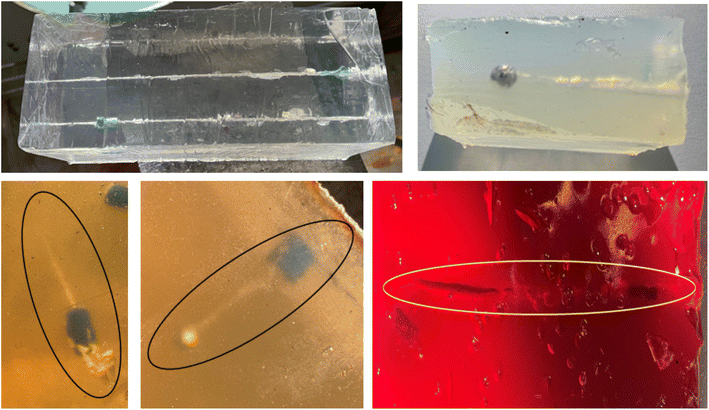 | ||
| Fig. 8 Cavitation in materials: Perma-Gel (top left), ballistic soap (top right), 10% gelatine (bottom left), 20% gelatine (bottom middle) and Hartley's jelly (bottom right). | ||
Although not considered within the performance weighting assessment, understanding failure modes of materials, and therefore the materials ability to be reused due to elastic recovery was considered during physical test and results used during the environmental weighting at latter stages of this study. As evidenced in Fig. 9 – entry and exit failure modes and wound tracking of the ball bearing inside of 10% gelatine, 20% gelatine, Perma-Gel and Hartley's jelly elastic deformation was witnessed which varied in size as the projectile travelled through the depth of the material. Where perforation was apparent, petaling of the back face of the material varied in magnitude before the elastic recovery phase began and the failure withdrawn. Post impact analysis of the high-speed video footage shows no shockwaves induced to the material as a result of the high-speed impacts. The above results and observations should be caveated by the assumption that no material performance degradation had occurred because of multiple firings being conducted on the same block of material.
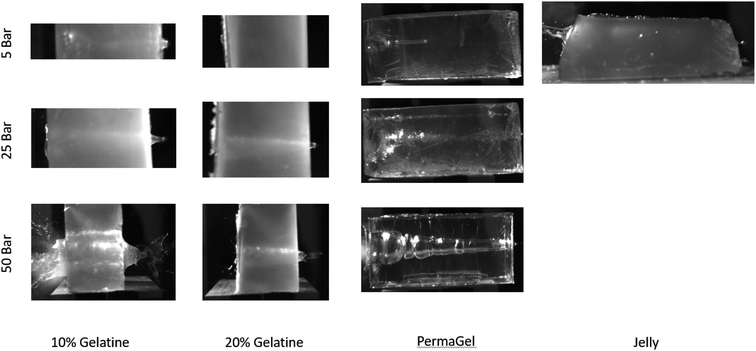 | ||
| Fig. 9 Entry and exit failure modes and wound tracking of the ball bearing inside of 10% gelatine, 20% gelatine, Perma-Gel and Hartley's jelly. | ||
When considering material failure, results from both 25 and 50 bar firings show very similar results in terms of displacement of material on the front face for both RP1 and plastiline. Displacing material is advantageous for back face signature/BABT measurement,51,56–59 but not for the examination of wound ballistics metrics. The results shown for RP1 and plastiline were similar to those seen with ballistic soap which produced minor fragmentation from the front face upon impact at the lower velocities which increased proportionally as the velocity was increased. Examination HSV footage shows that fragmentation was also present during perforation which occurred during the 25 and 50 bar firings. This can be seen in Fig. 10 – ballistic soap fragmentation at 5 (left), 25 (middle), 50 (right) bar.
The above results show that materials that are elastic in nature are more advantageous to survivability assessment due to ability to capture both permanent and temporary cavitation during the same test. The elastic materials in this study were also more transparent than materials that exhibited plastic responses which enables users to capture and examine results in higher quality resolution and aid in post experiment analysis thereby strengthening the integrity of the results. In addition, the materials ability to recover post impact allows for a multi-hit capability which has been used within this study. When considering the data, PermaGel performed most advantageously, followed by 20 and 10% gelatines respectively.
To facilitate use of the swing weight method, the authors were required to imagine a fictitious alternative material with every attribute at its worst level, as shown in the final row of Table 4 – performance attributes against best and worst values from the raw data set and acted as the ‘baseline material’.
| Performance | Residual exit velocity (m s−1) | DoP (mm) | Transparency | Perm cavity/elastic response |
|---|---|---|---|---|
| Best | 100.7 | 19 | Yes | Yes |
| Worst | 407.88 | Perforation | No | No |
Next, the authors had to judge which attribute swing from the worst to the best levels shown in Table 4 offered the most potential improvement. Permanent cavitation/elastic response offers the greatest improvement to the baseline fictitious material due to the ability for the user to analyse both temporary and permanent cavitation, which is supported by ref. 2, 4 and 60–63. This improvement swing, judged the most valuable, was given a notional value of 100.
The authors were required to subsequently assess the relative levels of overall value improvement which would be associated with the swings from worst to best on each of the other attributes.
Transparency was awarded 60% of the swing on the same notional scale as permanent cavitation and was deemed the second most important attribute to ensure understanding of shock transfer from projectile impact, wound track assessment and lethality of projectiles as evidenced in ref. 64–69. This was scored lower than elastic response, due to the varying degrees of transparency that can be used dependant on requirement as shown in Fig. 9 – entry and exit failure modes and wound tracking of the ball bearing inside of 10% gelatine, 20% gelatine, Perma-Gel and Hartley's jelly.
The process of ranking attributes continued until all attributes were ranked as per Table 5 – swing weighting – performance metrics.
A series of normalised weights were subsequently produced by dividing the notional values attached to each attribute by the sum of all the direct weights (200) as per Table 6 – normalised weights – performance to produce a normalised sum of 1. Finally, Table 7 – weighting the benefits of materials tested – performance shows the direct rating scoring procedure in which a subjective assessment of each material's performance based on the raw data set was assessed on the scale of 0–100 with 0 given for the worst performing and 100 for the best performing on that attribute. Where performance fell between 0–100, this was scored based on the results from the raw data with higher numbers representing better levels of performance.
| Attribute | Original weights | Normalised weights |
|---|---|---|
| Residual exit velocity | 10 | 0.05 |
| DoP | 30 | 0.15 |
| Transparency | 60 | 0.3 |
| Perm cavity/elastic response | 100 | 0.5 |
| Total | 200 | 1 |
| Material | Residual exit velocity (0.05) | DoP (0.15) | Transparency (0.3) | Perm cavity/elastic response (0.5) | Weighted TOT |
|---|---|---|---|---|---|
| 10% gelatine | 0 | 0 | 80 | 80 | 64 |
| 20% gelatine | 30 | 70 | 70 | 90 | 78 |
| PermaGel | 60 | 100 | 100 | 100 | 98 |
| Jelly | Not scored due to insufficient data across all 3 velocities measured | ||||
| RP1 | 80 | 60 | 0 | 0 | 13 |
| Plastiline | 100 | 85 | 0 | 0 | 17.75 |
| Ballistic soap | 50 | 75 | 10 | 0 | 16.75 |
Assessment of the results provided confirmation that the results shown from the raw data were also consistent with the swing weighting procedure. PermaGel scored maximum values across most metrics except for residual exit velocity. When assessing the performance of the material, this is of limited interest and the direct weights for this study were placed to reflect this. The residual exit velocity can be directly attributed to material density, where the projectile has not been subjected to a medium that has the ability to counteract input velocity, thereby allowing the projectile to exit at faster rates. This swing was weighted lowest, as increased depths of material could be used to counteract for lower density materials. Fig. 9 – entry and exit failure modes and wound tracking of the ball bearing inside of 10% gelatine, 20% gelatine, Perma-Gel and Hartley's jelly and Fig. 10 – ballistic soap fragmentation at 5 (left), 25 (middle), 50 (right) bar clearly show that Perma-Gel is also most transparent and therefore allowed for easy examination of wound ballistic profiles using both high speed video camera and visual analysis post firing. By comparison 10% was observed to be slightly less transparent and 20% exhibiting signs of clouding. Although results could still be distinguished using both gelatines under test, this does have the ability to cause issues in test settings that have low lighting or high-speed video equipment of insufficient quality. 20% gelatine has historically been used in countries where full metal jacket rounds are in service, and therefore requires the material to be denser thereby increasing its elastic strength.8,70 The additional material used during manufacture of 20% attributes to this characteristic and therefore influences the residual exit velocity similar in the same way described for PermaGel.
It is of note that the Hartley's jelly tested within the same assessment did show some promising signs of suitability as a material to be used within survivability/lethality assessment. As shown in Fig. 8 – cavitation in materials: Perma-Gel (top left), ballistic soap (top right), 10% gelatine (bottom left), 20% gelatine (bottom middle) and Hartley's jelly (bottom right) and Fig. 9 – entry and exit failure modes and wound tracking of the ball bearing inside of 10% gelatine, 20% gelatine, Perma-Gel and Hartley's jelly, the materials elasticity is sufficient to allow measurement of both temporary and permanent cavitation. Both DoP and exit velocities scored negatively during this assessment and it is proposed that this is due to consistency of manufacture. As previously stated, this was manufactured to the guidelines provided by the supplier and is therefore considered to be more viable for consumption as a foodstuff's material in its current state. Further work examining the consistency and therefore the density of the material should be explored to ensure materials with the highest economic viability are considered fairly.
Materials that did not exhibit elastic response scored lowest when examining both raw data results and confirmed by the performance weighting assessment, scoring of which was differentiated by exit velocity and depth of penetration. Although not suitable for the measurement of as many metrics as materials that exhibited elastic response, these clearly have use where blunt trauma assessment or backing material where armour performance assessment is required.42,58 This is however contrary to previous studies in which it was reported that although plastilina shows plastic deformation, up to 40% elastic recovery was witnessed making post impact analysis difficult especially when not using high speed video footage.70 Roma plastilina no. 1 was initially recommended due to it being “cheap, readily available, and was a conservative analogue to the goat as a backing material”. It was reported that this technique was provisional since not enough data was available to validate it accuracy. However, plastilina has remained in service due to its practical success and relatively low cost.70 As cost and ready availability have been mentioned to be critical factors in selection of a suitable material for survivability, it is therefore important that this study considers the environmental implications of supply, manufacture, and use of these materials too.
As this study forms a crucial part to wider works focussing on the impact sustainability can have on soft tissue simulant selection, a desktop qualitative assessment using material data sheets, manufacturers websites and the open literature was used to analyse the environmental impact for each material under test.
3.2 Sustainability
Cost, availability, manufacturing, ability for re-use and source location were chosen as the attributes to analyse a soft tissue simulant's ability to perform both economically and environmentally. These metrics were based on the NATO ARSP-03 guidelines for witness capture material which has been successfully utilised for similar assessments in previous works.71 NATO ARSP-03 considers cost, availability and re-use but does not explicitly cover a requirement for researchers to consider environmental impact therefore making this work more prevalent. This standard was chosen as a suitable measure to base the attribute selection due to its approach to enhancing material development and datasets.Analysis of the costings in Table 8 – material cost‡ show that although plastic materials performed least advantageously during performance assessment, they are also the most expensive when purchased from the suppliers within this study. The same trend was apparent for availability, in which materials with more elastic responses were easier to obtain on the open market with more suppliers stocking products, whilst materials such as Roma plastilina and plastiline were more difficult to obtain, coming from the US and France respectively. The swing on cost per mould was deemed least valuable during the direct rating procedure, subsequently being valued at 20% of the swing on the highest ranked attribute. Reusability, due to swings on environmental factors being rated more highly and the recent drives to produce materials that align to the government's ambition to cut carbon emissions and improve environmental impact.2,72,73 Swing on availability however was valued at 80% of the swing on reusability due to the need to have materials to conduct research in the first place.
| Material | Cost per mould |
|---|---|
| 10% gelatine | £13.13 |
| 20% gelatine | £26.25 |
| Perma-gel | £61.04 |
| Hartley's jelly | £2.00 |
| Ballistic soap | £9.62 |
| Roma plastilina no. 1 | £120.53 |
| Plastiline | £64.80 |
Although noted that Roma plastilina and plastiline was sourced from the US and France respectively, of the eight materials tested only Hartley's jelly and ballistic soap were sourced within the UK. The remainder of the materials were sourced and delivered from the United States, Germany, France, and The Netherlands. This equates to 75% of the materials being sourced from abroad and being delivered in air, sea, and road transport methods. As the UK government is driving toward net zero 2050 and incentivising UK industry to make improvements to its carbon emissions,2 this swing on UK sourcing was valued at 50% of the swing on reusability.
Another key metric was to analyse if manufacturing was required, this was of interest due to possibility of excessive water consumption and where uncontrolled, excessive waste produced. Excessive water consumption has been defined as any additional water required above and beyond the trial requirement to manufacture or reproduce materials due to manufacturing variations or damage caused during preparation. The term excessive also considers the cleaning of instruments used during manufacture and preparation. The expected environmental impact is mainly focussed on the productivity of flora and fauna but will also require additional demand on the water recycling/treatment centres. By contrast, excessive waste has been defined as additional material requiring disposal due manufacturing, preparation, or single use items. The expected impact of excessive waste is the contamination of the soil and therefore a deterioration in the productivity of flora and fauna. In extreme cases excessive waste has the possibility of also increasing a pollutant risk to waterways and wildlife. Excessive water consumption and waste produced were chosen as the two metrics used to define sustainability due to the materials under test relying heavily on water 90![[thin space (1/6-em)]](https://www.rsc.org/images/entities/char_2009.gif) :
:![[thin space (1/6-em)]](https://www.rsc.org/images/entities/char_2009.gif) 10 or 80
10 or 80![[thin space (1/6-em)]](https://www.rsc.org/images/entities/char_2009.gif) :
:![[thin space (1/6-em)]](https://www.rsc.org/images/entities/char_2009.gif) 20 water/weight to generate the correct mechanical properties for ballistic testing and the ‘1 use’ nature of the materials' ability to generate waste more rapidly and in greater quantities during ballistic trials.
20 water/weight to generate the correct mechanical properties for ballistic testing and the ‘1 use’ nature of the materials' ability to generate waste more rapidly and in greater quantities during ballistic trials.
Within this study 10 and 20% gelatine materials, foodstuffs gelatine was delivered in powder form and as such required manufacture as per the suppliers' instructions. This was completed by using precisely measured quantities of water and leaving to cure overnight in a freezer. It should be noted that although this was done precisely by an experienced team of technicians, excessive water usage could easily become an issue if being manufactured by someone with little to no experience. By contrast, ballistic soap was delivered as a soap base, and required remelting before being poured into a mould and set using the same freezer. In all instances, excessive waste can become a major issue due to manufacturing errors and the potential for differences in batch manufacture.
Perma-Gel, RP1 and plastilina did not require any manufacture. Perma-Gel was ready to use once decanted from its packaging, whilst RP1 and plastiline required tamping/pouring into moulds before being placed within an oven to condition.
As many of the materials can be supplied pre-made at a higher cost, this was deemed to be of relatively low importance and was scored at 30% of the reusability swing during direct weighting.
To further explore manufacturing influence, a multi-metric comparison was generated to identify how much of an impact each material under test has when considering sustainability factors.
Energy was firstly considered due to the requirement for material conditioning and powering of appliances to cure the material post mould pour. Perma-Gel did not require any preconditioning and was supplied ready to use. 10%, 20% gelatines and ballistic soap used the most energy due to the need to the 48 hour cure time applied within this study. This was calculated using an assumed 313 kW h−1 energy consumption for a large chest freezer.74 This was followed by Hartley's jelly for the same reason albeit with a lower cure time thereby reducing the total energy usage. Roma plastilina used the least amount of energy, with 72 hour preconditioning time in an industrial oven estimated to consume 3 kW h−1. Although low in comparison to bulk manufacturing, these figures clearly present that traditional materials are least energy efficient, increasing power draw from the national grid and generating head whilst running.
Water use is vital when manufacturing using raw ingredients. Again, 10 and 20% gelatines required the most water at 3.24 l per mould, followed closely by Hartley's jelly at 3 l per mould. This figures validity is questioned by the products ability to perform advantageously. The figures presented here assume no water loss through error, however, clearly show that the water consumption per mould is low thereby limiting economic impact and reliance on water treatment plants.
Waste was next to be considered, limiting the amount of waste placed into landfill is a key driver in today's economy.75,76 To ensure this analysis was un-biased, it was assumed that the materials identified as reusable were at the end of their life and required permanent disposal. Table 9 – soft tissue simulant – energy/water/waste/CO2e mapping per mould shows that the differences in waste produced are negligible, however Perma-Gel performed most advantageously during this assessment generating 2.053 kg of waste per block which is interesting as it was bigger than the moulds produced for the rest of the materials. This is predicted to be due to manufacturing techniques using synthetic materials.40 Although providing the least waste, the influence on the wider environment from synthetic chemicals used to enhance transparency and limit material degradation are unknown.32,77,78
| Material | Energy (kW) | Water (L) | Waste (kg) | CO2e (kg) |
|---|---|---|---|---|
| 10% gelatine | 15![[thin space (1/6-em)]](https://www.rsc.org/images/entities/char_2009.gif) 024 024 |
3.24 | 3.6 | 12.16 |
| 20% gelatine | 15![[thin space (1/6-em)]](https://www.rsc.org/images/entities/char_2009.gif) 024 024 |
3.24 | 3.89 | 12.16 |
| Perma-Gel | 0 | 0 | 2.053 | 98.94 |
| Hartley's jelly | 7512.339 | 3 | 3.338 | 0.016 |
| Ballistic soap | 15![[thin space (1/6-em)]](https://www.rsc.org/images/entities/char_2009.gif) 024 024 |
0 | 2.49 | 0.84 |
| Roma plastilina no. 1 | 216 | 0 | 3.44 | 70.14 |
| Plastiline 40 | 72 | 0 | 3.6 | 0.18 |
Lastly is the measurement of carbon dioxide generated from the transportation between supplier and the research establishment used within this work. It is important to note that carbon dioxide is not the only greenhouse gas associated with climate change. Methane, nitrous oxide, and others also contribute to global warming and as such are combined with carbon dioxide to produce carbon dioxide equivalent – CO2e.28,29 For the purposes of this study, outputs of most commonly used methods of transport were calculated using figures listed within EN16258,79 weights of products gathered from invoices and assumptions made on most likely economic routes from supplier to receipt of goods. Predictably materials sourced from the US (Perma-Gel and RP1) scored highest, this is mainly due to air freight emissions produced from crossing the Atlantic Ocean, with the remainder generated to and from airports. This is followed by 10 and 20% gelatines whose raw material is sourced from Germany. The freight route used as part of this study was assumed again to be air cargo. The remainder of the materials were sourced within the UK and the figures provided below reflect the distance from the research establishment with Hartley's jelly being readily available less than 10 miles from the experimental site.
When considering cost, availability, supply chain impact and manufacturing, it was important to recognise the importance of re-useability. Re-useability would cut cost, reduce the reliance on availability by purchasing smaller quantities, which will also reduce carbon impact by reducing burden on the supply chain. As reported within previous works,2 10 and 20% gelatines have been reported to be ‘1 shot’ items, however, data was gathered from a maximum number of 4 shots per mould as part of this study, showing promise in repeatability as opposed to reusability. Additionally, Perma-Gel has been reported to be reusable, however concern has been raised around the number of times Perma-Gel can be melted and recured without degrading the materials performance.31 By contrast of elastic materials Hartley's jelly was shown not to be reusable in its current consistency.
In all instances where materials exhibited a plastic response, they were able to be reused once the projectile and sabot fragmentation was extracted from the material, so long as material conditioning requirements were adhered too.
Similar to performance, an environmental worst case material was produced using the qualitative desktop assessment data – Table 10 – environmental attributes assessed against best and worst values from the raw data set. Following the same procedure as completed for performance attributes, Table 11 – direct rating – environmental was produced and the subsequent direct rating and weighting of benefits found in Table 12 – normalised weights – environmental and Table 13 – weighting the benefits of materials tested – environmental respectively.
| Environmental | Cost per mould | Availability | Manufacture required? | UK sourced? | Re-useable? |
|---|---|---|---|---|---|
| Best | £2 | Easy | No | Yes | Yes |
| Worst | £120.53 | Limited | Yes | No | No |
| Attribute | Original weights | Normalised weights |
|---|---|---|
| Cost per mould | 20 | 0.071 |
| Manufacture required | 30 | 0.107 |
| UK sourced | 50 | 0.179 |
| Availability | 80 | 0.286 |
| Re-useable | 100 | 0.357 |
| Total | 280 | 1 |
| Material | Cost per mould (0.071) | Availability (0.286) | Manufacture required (0.107) | UK sourced (0.179) | Re-useable (0.357) | Weighted TOT |
|---|---|---|---|---|---|---|
| 10% gelatine | 70 | 100 | 0 | 0 | 0 | 33.57 |
| 20% gelatine | 50 | 100 | 0 | 0 | 0 | 32.15 |
| PermaGel | 35 | 100 | 100 | 0 | 100 | 77.485 |
| Jelly | 100 | 100 | 0 | 100 | 0 | 53.6 |
| RP1 | 0 | 0 | 100 | 0 | 100 | 46.4 |
| Plastiline | 30 | 0 | 100 | 0 | 100 | 48.53 |
| Ballistic soap | 50 | 100 | 0 | 100 | 100 | 85.75 |
As discussed previously, performance related metrics should not be considered in isolation and the ever-stringent environmental requirements placed on both Civilian and Defence industries2 require materials to be continually assessed for economic viability. In this instance, ballistic soap, PermaGel and jelly ranked highest (respectively) within this assessment.
This result is interesting as ballistic soap scored 5th within the performance assessment yet benefits from being economically priced, readily available within UK and can be melted and remoulded therefore enabling it to be reusable and limiting the amount of waste produced. PermaGel by comparison was the top scorer within the performance assessment and was calculated to be the 2nd highest scoring material within this assessment. The ease of availability, consideration of reusability and the lack of manufacturing required on customer sites thereby reducing the risk of excessive water consumption and increased waste produced by uncontrolled techniques and discrepancies made during construction between researchers. Although the material is not UK sourced and scored low in comparison to the other materials when considering cost, environmentally friendly measures such as bulk ordering within the same or paired universities can minimise the CO2 emissions produced by the supply chain.
Again, of interest is jelly, although negated from the performance assessment, it has been considered here to assess its economic viability and therefore assess whether material development is worth pursuing. Scoring 3rd, jelly provides the best value for money which when using the moulds within this study provided an 85% saving when compared to 10% gelatine for a single mould. 10% gelatine was chosen as the comparison to jelly due to its less dense nature (when compared to 20% gelatine) and the similar observations when examining cavitation. Noting the issues surrounding consistency of the jelly, when enhancing the material density by using additional jelly mixture to the mould size used within this study, the following savings (Table 14 – comparison of economic viability of Hartley's jelly and 10% gelatine) were calculated using eqn (1) – Price difference.
 | (1) |
| Jelly packs used | Jelly price | 10% gelatine price | Difference (%) |
|---|---|---|---|
| 2.5 | £2.00 | £13.13 | 85 |
| 5 | £4.00 | £13.13 | 70 |
| 7.5 | £6.00 | £13.13 | 54 |
Although purchased from an off the shelf supermarket retailer, no issues are predicted to be encountered if ordered in bulk directly from the supplier within the UK. Although manufacture is required on site, water consumption would be minimised due to its ability to elastically recover in short time durations allowing for numerous shots to be conducted on the same mould.
From both the performance and environmental weighting analysis that was conducted using the results gathered from the raw data, we can see that Perma-Gel is the most advantageous soft tissue simulant when considering both performance and environmental factors. The rankings for second and third place spots become harder to analyse, however it is hypothesised that foodstuffs gelatine would come second upon successful characterisation of the material. Its clear economic benefits make it hard to disregard and post impact analysis show transparency and cavitation more closely linked to 10% gelatine. Thirdly, 20% gelatine has excelled within the performance assessment and whilst scoring lowest in the environmental weighting, is similar to the 10% construct when price is concerned. The marginal difference in economic value does not match the difference in performance seen during this experiment and for that reason is considered acceptable. Additionally, the 20% gelatine has been demonstrated to be more suited to testing NATO ammunition due to their unique construct70 which is of more interest to the studies presented here due to the country of research origin.
Although the weightings show materials with plastic response perform less advantageous than those with higher elasticity, this is subjective and based on the metrics chosen for this study. There are clear environmental benefits to these materials and as evidenced in the discussion above, the difference in environmental benefits for survivability assessment are substantial compared to materials concerned with measuring both temporary and permanent cavitation.
Both sets of material responses are still required for use within survivability assessment and the variable under consideration within this study is velocity. It is therefore proposed that this study be repeated where velocity is a constant and the effect on projectile diameter is explored. The results should be compared with the discussion made within this chapter and a full down selection criterion be made to further examine three materials for the remainder of these works.
4 Conclusions
A literature review has revealed a paucity of information on the economic and environmental impact when choosing materials for use within survivability assessment. Specifically, lack of research into the sustainability of current materials, supply chain impact and the wider economic trade-offs have left the research community with gaps in the literature. Although many refer to performance characteristics, lack of environmental consideration during increasing worldwide awareness of both environmental and sustainable measures leaves this field of research at risk of not complying to wider government ambitions.During this experimental series, seven commercially available materials have undergone both performance testing at velocities ranging from 122 to 526 m s−1 and qualitative environmental analysis. The results of which show that the raw data output aligns to the performance-based swing weighting method enacted for this study resulting in PermaGel, 20 and 10% gelatines respectively scoring higher than the other 5 materials placed under test. This was contradicted when an environmental weighting was applied, resulting in ballistic soap, PermaGel and foodstuffs gelatine ranking highest respectively.
This work has shown that when environmental considerations are included within the material viability assessment made at the start of any research programme, careful consideration should be given to the environmental impact produced by the supply chain and a cost benefit analysis undertaken to provide economic value for money. Further work should be conducted to further assess Perma-Gel and its applicability in scenarios requiring high volumes of repeatable testing and the viability of maturing the performance characteristics of foodstuffs gelatine as an emerging contender to reduce the environmental impact. These two materials should be developed by using ballistic gelatine as a comparative baseline material noting its proven applicability within the field of survivability assessment.
Author contributions
James Read: conceptualization, data curation, formal analysis, funding acquisition, investigation, methodology, project administration, resources, validation, visualization, writing – original draft, writing – review & editing. Ken McNaught: methodology, writing – review & editing. Richard Critchley: writing – review & editing, supervision. Rachael Hazael: writing – review & editing, supervision.Conflicts of interest
The authors declare that they have no known competing financial interests or personal relationships that could have appeared to influence the work reported in this paper.Acknowledgements
This research was supported by Cranfield Forensics Institute and Defence Equipment and Support. The authors of this paper would like to extend thanks to Andrew Roberts and Dave Miller for conducting the gas gun experimentation as well as the Cranfield Defence and Security Workshops for the construction of the moulds used within this research.References
- G. J. Appleby-Thomas, B. Fitzmaurice, A. Hameed, J. Painter, M. Gibson and D. C. Wood, et al., On differences in the equation-of-state for a selection of seven representative mammalian tissue analogue materials, J. Mech. Behav. Biomed. Mater., 2018, 77, 586–593, DOI:10.1016/J.JMBBM.2017.10.012 , accessed: 19 April 2023..
- J. Read, R. Hazael and R. Critchley, Soft Tissue Simulants for Survivability Assessment—A Sustainability Focussed Review, Appl. Sci., 2022, 12(10), 4954, DOI:10.3390/APP12104954 , accessed: 19 April 2023..
- Y. Wen, C. Xu, H. Wang, A. Chen and R. C. Batra, Impact of steel spheres on ballistic gelatin at moderate velocities, Int. J. Impact Eng., 2013, 62, 142–151, DOI:10.1016/J.IJIMPENG.2013.07.002 , accessed: 16 May 2023..
- R. M. Coupland, M. A. Rothchild, M. J. Thali and B. P. Kneubuehl, Wound Ballistics : Basics and Applications, Springer Medizin, 2011, pp. 87–137, https://www.vlebooks.com/Product/Index/592174?page=0, accessed: 21 April 2022 Search PubMed.
- N. R. Maiden, W. Fisk, C. Wachsberger and R. W. Byard, Ballistics ordnance gelatine – How different concentrations, temperatures and curing times affect calibration results, J. Forensic Leg. Med., 2015, 34, 145–150, DOI:10.1016/J.JFLM.2015.05.019.
- N. R. Maiden, The Assessment of Bullet Wound Trauma Dynamics and the Potential Role of Anatomical Models, PhD thesis, University of Adelaide, Adelaide, 2014, pp. 1–204, https://digital.library.adelaide.edu.au/dspace/bitstream/2440/99527/2/02whole.pdf, accessed: 21 April 2022.
- D. D. Amick, Perma-Gel Product Overview (Wayback Machine), 2006, https://web.archive.org/web/20071012202123/http://perma-gel.com/ Search PubMed.
- A. Mabbott, D. J. Carr, S. Champion and C. Malbon, Comparison of porcine thorax to gelatine blocks for wound ballistics studies, Int. J. Leg. Med., 2016, 130(5), 1353–1362, DOI:10.1007/s00414-015-1309-9 , accessed: 23 September 2020..
- G. Appleby-Thomas and B. F. J. P. D. W. Amer Hameed, On the Selection of Tissue Simulants for Ballistic Testing, 29th International Symposium on Ballistics, 2016, https://www.dpi-proceedings.com/index.php/ballistics/article/view/2267, accessed: 19 April 2023 Search PubMed.
- F. Riva, E. J. A. T. Mattijssen and W. Kerkhoff, Rifle bullet deflection through a soft tissue simulant, Forensic Sci. Int., 2018, 291, 199–206, DOI:10.1016/J.FORSCIINT.2018.08.024 , accessed: 19 April 2023..
- C. A. Bir, M. Resslar and S. Stewart, Skin penetration surrogate for the evaluation of less lethal kinetic energy munitions, Forensic Sci. Int., 2012, 220(1–3), 126–129, DOI:10.1016/J.FORSCIINT.2012.02.008 , accessed: 19 April 2023..
- V. J. M. DiMaio, A. R. Copeland, P. E. Besant-Matthews, L. A. Fletcher and A. Jones, Minimal velocities necessary for perforation of skin by air gun pellets and bullets, J. Forensic Sci., 1982, 27(4), 12207J, DOI:10.1520/JFS12207J , accessed: 19 April 2023..
- L. A. Fenton, I. Horsfall and D. J. Carr, Skin and Skin Simulants, 2018, 52(1), 96–106, DOI:10.1080/00450618.2018.1450896 , accessed: 19 April 2023..
- J. Breeze and J. C. Clasper, Determining the velocity required for skin perforation by fragment simulating projectiles: A systematic review, J. Roy. Army Med. Corps, 2013, 159(4), 265–270, DOI:10.1136/JRAMC-2013-000070 , accessed: 19 April 2023..
- L. C. Haag, A Forensic Firearms Examiner's Lament, Acad. Forensic Pathol., 2013, 3(2), 164–170, DOI:10.23907/2013.021/FORMAT/EPUB , accessed: 19 April 2023..
- J. Jussila, A. Leppäniemi, M. Paronen and E. Kulomäki, Ballistic skin simulant, Forensic Sci. Int., 2005, 150(1), 63–71, DOI:10.1016/J.FORSCIINT.2004.06.039 , accessed: 19 April 2023..
- A. Papy, C. Robbe, N. Nsiampa, A. Oukara and J. Goffin, Definition of a Standardized Skin Penetration Surrogate for Blunt Impacts, 2012 Search PubMed.
- R. A. G. Hes, J. D. Painter and G. J. Appleby-Thomas, Optimal skin simulant for ballistic testing, Forensic Sci. Int., 2023, 346, 111653, DOI:10.1016/J.FORSCIINT.2023.111653 , accessed: 16 May 2023..
- C. Bir, C. Andrecovich, M. DeMaio and P. J. Dougherty, Evaluation of bone surrogates for indirect and direct ballistic fractures, Forensic Sci. Int., 2016, 261, 1–7, DOI:10.1016/J.FORSCIINT.2016.01.023 , accessed: 19 April 2023..
- B. J. Henwood and G. Appleby-Thomas, The suitability of Synbone® as a tissue analogue in ballistic impacts, J. Mater. Sci., 2020, 55(7), 3022–3033, DOI:10.1007/S10853-019-04231-Y/FIGURES/12 , accessed: 19 April 2023..
- E. Budak, F. Beytar, M. Özdemir, B. N. Susam, M. Göker and A. Ünlü, et al., Lower limb phantom design and production for blood flow and pressure tests, Eurobiotech J., 2017, 1(4), 278–284, DOI:10.24190/ISSN2564-615X/2017/04.04 , accessed: 19 April 2023..
- D. Carr, A. C. Lindstrom, A. Jareborg, S. Champion, N. Waddell and D. Miller, et al., Development of a skull/brain model for military wound ballistics studies, Int. J. Leg. Med., 2015, 129(3), 505–510, DOI:10.1007/S00414-014-1073-2/FIGURES/3 , accessed: 19 April 2023..
- A. G. Synbone, Synbone at A Glance, 2017 Search PubMed.
- A. G. Synbone, Online Catalogue - Forensic and Ballistic, 2023, https://www.synbone.com/product-category/biomechanics-generics/forensic-and-ballistic/?shop_currency=CHF, accessed: 19 April 2023 Search PubMed.
- Sawbones, Biomechanical Materials for Precise, Repeatable Testing, 2023, https://www.sawbones.com/biomechanical-product-info, accessed: 19 April 2023 Search PubMed.
- P. F. Mahoney, D. J. Carr, R. J. Delaney, N. Hunt, S. Harrison and J. Breeze, et al., Does preliminary optimisation of an anatomically correct skull-brain model using simple simulants produce clinically realistic ballistic injury fracture patterns?, Int. J. Leg. Med., 2017, 131(4), 1043–1053, DOI:10.1007/S00414-017-1557-Y/TABLES/7 , accessed: 19 April 2023..
- A. D. Brown, J. B. Walters, Y. X. Zhang and M. Saadatfar, Escobedo-Diaz JP., Hazell PJ. The mechanical response of commercially available bone simulants for quasi-static and dynamic loading, J. Mech. Behav. Biomed. Mater., 2019, 90, 404–416, DOI:10.1016/J.JMBBM.2018.10.032 , accessed: 16 May 2023..
- M. Brander, Greenhouse Gases, CO2, CO2e, and Carbon: What Do All These Terms Mean?, 2012, https://bluemangrove.fund/wp-content/uploads/2021/03/Glossary-on-different-CO2-terms.pdf, accessed: 16 May 2023 Search PubMed.
- Eurostat, Carbon Dioxide Equivalent - Statistics Explained, 2001, https://ec.europa.eu/eurostat/statistics-explained/index.php?title=Glossary:Carbon_dioxide_equivalent, accessed: 16 May 2023 Search PubMed.
- P. Moy, M. Foster, C. A. Gunnarsson and T. Weerasooriya, Loading rate effect on tensile failure behavior of gelatins under mode I, Conference Proceedings of the Society for Experimental Mechanics Series, Springer New York LLC, 2011, vol. 1, pp. 15–23, DOI:10.1007/978-1-4419-8228-5_4/COVER, accessed: 4 October 2022.
- A. Mabbott and A. J. MABBOTT, The Overmatching of UK Police Body Armour, Cranfield University, Swindon, 2015, https://dspace.lib.cranfield.ac.uk/handle/1826/10515 Search PubMed.
- D. J. Carr, T. Stevenson and P. F. Mahoney, The use of gelatine in wound ballistics research, Int. J. Leg. Med., 2018, 132(6), 1659–1664, DOI:10.1007/s00414-018-1831-7 , accessed: 21 April 2022..
- L. Merkhofer, Assessing Weights, https://www.prioritysystem.com/reasons4i.html, accessed: 14 February 2023 Search PubMed.
- G. S. Parnell and T. E. Trainor, Using the swing weight matrix to weight multiple objectives, 19th Annual International Symposium of the International Council on Systems Engineering, INCOSE, 2009, vol 1, pp. 283–298, DOI:10.1002/J.2334-5837.2009.TB00949.X, accessed: 14 February 2023.
- B. Cottom, Swing Weights, Why Are They Important?, 2019, p. 1, https://onlinepubs.trb.org/onlinepubs/Conferences/2019/PerformanceData/BCottam.pdf, accessed: 14 February 2023 Search PubMed.
- B. Németh, A. Molnár, S. Bozóki, K. Wijaya, A. Inotai and J. D. Campbell, et al., Comparison of weighting methods used in multicriteria decision analysis frameworks in healthcare with focus on low-and middle-income countries, J. Comp. Eff. Res., 2019, 8(4), 195–204, DOI:10.2217/CER-2018-0102/ASSET/308645EE-56B8-43BD-B1DC-57556F525348/ASSETS/IMAGES/LARGE/FIGURE1.JPG , accessed: 14 February 2023..
- T. Payne, S. O'Rourke and C. Malbon, Body Armour Standard (2017), 012/17 United Kingdom: UK Home Office, 2017, p. 92, https://assets.publishing.service.gov.uk/government/uploads/system/uploads/attachment_data/file/634517/Home_Office_Body_Armour_Standard.pdf Search PubMed.
- GELITA, GELITA ® BALLISTIC Gelatine, 2020, pp. 1–4, available at: https://www.gelita.com/sites/default/files/documents/2020-03/Ballisticgelatine2020.pdf, accessed: 19 April 2023 Search PubMed.
- J. Jussila, Preparing ballistic gelatine—review and proposal for a standard method, Forensic Sci. Int., 2004, 141(2–3), 91–98, DOI:10.1016/J.FORSCIINT.2003.11.036 , accessed: 19 April 2023..
- Ballistic Dummy Lab, Perma-Gel 9x4x4 Ballistic Gel Block, https://ballisticdummylab.com/collections/ballistic-blocks-1/products/perma-gel-9x4x4, accessed: 19 April 2023 Search PubMed.
- T. Payne, S. O'Rourke and C. Tichler, Home Office Body Armour Standard. Legislation, 2017, https://www.gov.uk/government/publications/home-office-body-armour-standard-2017, accessed: 10 October 2022 Search PubMed.
- J. Croft and D. Longhurst, HOSDB Body Armour Standards for UK Police (2007) – Part 2: Ballistic Resistance’. 39/07/B Home Office, 2007, pp. 1–36, https://www.bodyarmornews.com/wp-content/uploads/2013/10/HOSDB__2007_-_part_2.pdf, accessed: 21 April 2022 Search PubMed.
- J. Herbin, Hardness 40 -Professional Modeling Plastiline- - Feroca -Soluciones para el Moldeo, https://www.feroca.com/en/chavant-monster-clay-and-professional-clay/288-j-herbin-hardness-40-professional-modeling-clay.html, accessed: 4 October 2022 Search PubMed.
- Plastiline Ivory Modelling Clay|50,000+ Art Supplies|Your Art Superstore, https://www.greatart.co.uk/plastiline-ivory-modelling-clay.html, accessed: 4 October 2022 Search PubMed.
- Neills Materials, Plastiline 40, https://www.neillsmaterials.co.uk/product/plastiline-40/, accessed: 4 October 2022 Search PubMed.
- Jacobson Chemicals, Plastiline 40, https://www.jacobsonchemicals.co.uk/products-page/modelling-materials/plastiline-40/, accessed: 4 October 2022 Search PubMed.
- ASDA, Hartley's Strawberry Flavour Jelly, 2023, https://groceries.asda.com/product/jelly/hartleys-strawberry-flavour-jelly/19444, accessed: 19 April 2023 Search PubMed.
- 5.5 mm Diameter Grade 100 Hardened AISI 420 Stainless Steel Ball Bearings Simply Bearings Ltd, https://simplybearings.co.uk/shop/p222722/5.5mm-Diameter-Grade-100-Hardened-AISI-420-Stainless-Steel-Ball-Bearings/product_info.html, accessed: 4 October 2022 Search PubMed.
- A. Balci, M. Brøns, B. Thawani, T. Batchelor, J. Painter and R. Hazael, et al., Multi-impact response of CR4 mild steel: characterising the transition from absorption to failure, Eng. Res. Exp., 2023, 5(1), 015061, DOI:10.1088/2631-8695/ACC0DE , accessed: 19 April 2023..
- N. C. Nicholas and J. R. Welsch, Institute for Non-lethal Defense Technologies Report: Ballistic Gelatin, Pennsylvania, USA, 2004, https://www.researchgate.net/publication/235099580_Institute_for_Non-Lethal_Defense_Technologies_Report_Ballistic_Gelatin, accessed: 21 April 2022 Search PubMed.
- J. Read, R. Hazael and R. Critchley, Penetration performance of protective materials from crossbow attack: a preliminary study, Forensic Sci., Med., Pathol., 2023, 1–11, DOI:10.1007/S12024-023-00598-2 , accessed: 19 April 2023..
- K. Sellier and B. Kneubuehl, Wound Ballistics and the Scientific Background, Elsevier, 1994, p. 479 Search PubMed.
- T. T. N. Nguyen, H. Tsukada, J. Breeze and S. D. Masouros, The Critical Role of a Backing Material in Assessing the Performance of Soft Ballistic Protection, Hum. Factors Mech. Eng. Def. Saf., 2022, 6(1), 1–11, DOI:10.1007/S41314-022-00052-1/FIGURES/6 , accessed: 16 May 2023..
- L. Liu, Y. Fan and W. Li, Viscoelastic shock wave in ballistic gelatin behind soft body armor, J. Mech. Behav. Biomed. Mater., 2014, 34, 199–207, DOI:10.1016/J.JMBBM.2014.02.011 , accessed: 16 May 2023..
- Y. Fu, H. Lu, G. Nian, P. Wang, N. Lin and X. Hu, et al., Size-dependent inertial cavitation of soft materials, J. Mech. Phys. Solids, 2020, 137, 103859, DOI:10.1016/J.JMPS.2019.103859 , accessed: 16 May 2023..
- L. Cannon, Behind Armour Blunt Trauma - An Emerging Problem, BMJ Mil. Healt, 2001, 147, 87–96, DOI:10.1136/jramc-147-01-09 , accessed: 19 April 2023..
- D. J. Carr, I. Horsfall and C. Malbon, Is behind armour blunt trauma a real threat to users of body armour? A systematic review, BMJ Mil. Healt, 2016, 162(1), 8–11, DOI:10.1136/JRAMC-2013-000161 , accessed: 19 April 2023..
- L. Gilson, L. Rabet, A. Imad and F. Coghe, Experimental and numerical characterisation of rheological properties of a drop test response of a ballistic plastilina, Forensic Sci. Int., 2020, 310, 110238, DOI:10.1016/J.FORSCIINT.2020.110238 , accessed: 19 April 2023..
- E. A. Lewis, I. Horsfall and C. H. Watson, A Comparison of the behind Armour Blunt Trauma Effects between Ceramic Faced and Soft Body Armours Caused by Ballistic Impact, 2002, https://dspace.lib.cranfield.ac.uk/handle/1826/8734, accessed: 19 April 2023 Search PubMed.
- J. Aditya Pramudita, M. Sasaki, M. Ito, R. Watanbe and Y. Tanabe, Mechanical Characterization of Soft Tissue Simulant Materials, Adv. Exp. Mech., 2017, 2, 135–140 Search PubMed , https://www.researchgate.net/publication/321490648_Mechanical_Characterization_of_Soft_Tissue_Simulant_Materialsaccessed: 19 April 2023..
- A. I. Uzar, M. Dakak, T. Özer, G. Ogunc, T. Yigit and C. Kayahan, et al., A New Ballistic Simulant ‘Transparent Gel Candle’ (Experimental Study), Turkish J. Trauma Emerg. Surg., 2003, 9(2), 104–106 Search PubMed , https://jag.journalagent.com/travma/pdfs/UTD_9_2_104_106.pdfaccessed: 19 April 2023..
- S. Aghayan and K. Weinberg, Experimental and numerical investigation of dynamic cavitation in agarose gel as a soft tissue simulant, Mech. Mater., 2022, 175, 104486, DOI:10.1016/J.MECHMAT.2022.104486 , accessed: 19 April 2023..
- J. Breeze and D. J. Carr, Physical Models: Tissue Simulants. Blast Injury Science and Engineering, Springer, Cham, 2016, pp. 145–153, DOI:10.1007/978-3-319-21867-0_11, accessed: 19 April 2023.
- B. P. Kneubuehl, R. M. Coupland, M. A. Rothschild and M. J. Thali, Wound Ballistics: Basics and applications, Int. J. Leg. Med., 2011, 143–147, DOI:10.1007/S00414-012-0744-0/METRICS , accessed: 19 April 2023..
- C. Humphrey and J. Kumaratilake, Ballistics and anatomical modelling – A review, Leg. Med., 2016, 23, 21–29, DOI:10.1016/J.LEGALMED.2016.09.002 , accessed: 19 April 2023..
- F. Riva, P. Lombardo, W. D. Zech, C. Jackowski and C. Schyma, Individual synthetic head models in wound ballistics — A feasibility study based on real cases, Forensic Sci. Int., 2019, 294, 150–159, DOI:10.1016/J.FORSCIINT.2018.11.020 , accessed: 19 April 2023..
- C. Schyma, N. Herr, J. Brünig, E. Brenčičová and R. Müller, The influence of the counterfort while ballistic testing using gelatine blocks, Int. J. Leg. Med., 2017, 131(5), 1325–1332, DOI:10.1007/S00414-017-1623-5/FIGURES/9 , accessed: 19 April 2023..
- M. Pirlot, G. Dyckmans and I. Bastin, Soap and Gelatine for Simulating Human Body Tissue: an Experimental and Numerical Evaluation, 2001, pp. 7–11 Search PubMed.
- T. Stevenson, D. J. Carr, K. Harrison, R. Critchley, I. E. Gibb and S. A. Stapley, Ballistic research techniques: visualizing gunshot wounding patterns, Int. J. Leg. Med., 2020, 134(3), 1103–1114, DOI:10.1007/S00414-020-02265-5/TABLES/2 , accessed: 19 April 2023..
- T. Goode, G. Shoemaker, S. Schultz, K. Peters and M. Pankow, Soft body armor time-dependent back face deformation (BFD) with ballistics gel backing, Compos. Struct., 2019, 220, 687–698, DOI:10.1016/J.COMPSTRUCT.2019.04.025 , accessed: 14 February 2023..
- NATO, ARSP-03 Volume II - Guidance on the Development of Weapon Danger Areas/zones, NATO Allied Range Safety Publication, 2020 Search PubMed.
- UK Government, Ministry of Defence Climate Change and Sustainability Strategic Approach - GOV.UK, 2021, pp. 1–15, https://www.gov.uk/government/publications/ministry-of-defence-climate-change-and-sustainability-strategic-approach, accessed: 19 April 2023 Search PubMed.
- UK Government, Net Zero Strategy: Build Back Greener, Gov.UK, 2021, p. 368, https://www.gov.uk/government/publications/net-zero-strategy, accessed: 19 April 2023 Search PubMed.
- UK Chest Freezer, How Much Electricity Does a Chest Freezer Use?, 2023, https://www.ukchestfreezers.co.uk/chest-freezer-energy-consumption, accessed: 16 May 2023 Search PubMed.
- GOV.UK, Department for Environment F and RA and M. P. Rebecca Pow, Circular Economy Measures Drive Forward Ambitious Plans for Waste - GOV.UK, 2020, https://www.gov.uk/government/news/circular-economy-measures-drive-forward-ambitious-plans-for-waste, accessed: 16 May 2023 Search PubMed.
- Department for Environment F and RA, Greening Government Commitments 2021 to 2025, 2022, https://www.gov.uk/government/publications/greening-government-commitments-2021-to-2025/greening-government-commitments-2021-to-2025, accessed: 16 May 2023 Search PubMed.
- M. Wood, Comparing FBI Ballistic Gelatin with Synthetic Ballistic Gelatin, 2020, https://www.police1.com/police-products/firearms/accessories/ammunition/articles/ballistic-gelatin-comparisons-part-iii-IbjkEYB93TAd5o6J/, accessed: 16 May 2023 Search PubMed.
- J. J. Evans, A. Bost, K. H. Muci-Küchler and L. C. DeVeaux, Factors affecting use of ballistics gelatin in laboratory studies of bacterial contamination in projectile wounds, Mil. Med. Res., 2018, 5(1), 1–10, DOI:10.1186/S40779-018-0164-7/FIGURES/8 , accessed: 16 May 2023..
- CarbonCare, Calculation of CO2 Emissions According to EN16258 EU Standard Used by Carbon-Care, https://www.carboncare.org/en/co2-emissions-calculator/co2-emissions-values.html, accessed: 16 May 2023 Search PubMed.
Footnotes |
| † SEBS was considered as part of this research, however due to issues with suppliers, this material was not available for analysis. |
| ‡ Costs per mould were correct at the time of writing – 02/04/2023. |
| This journal is © The Royal Society of Chemistry 2024 |

